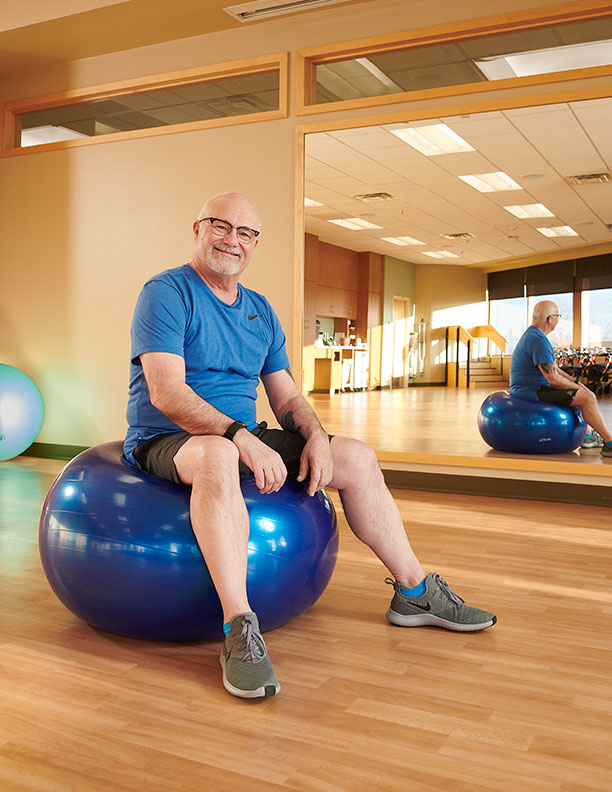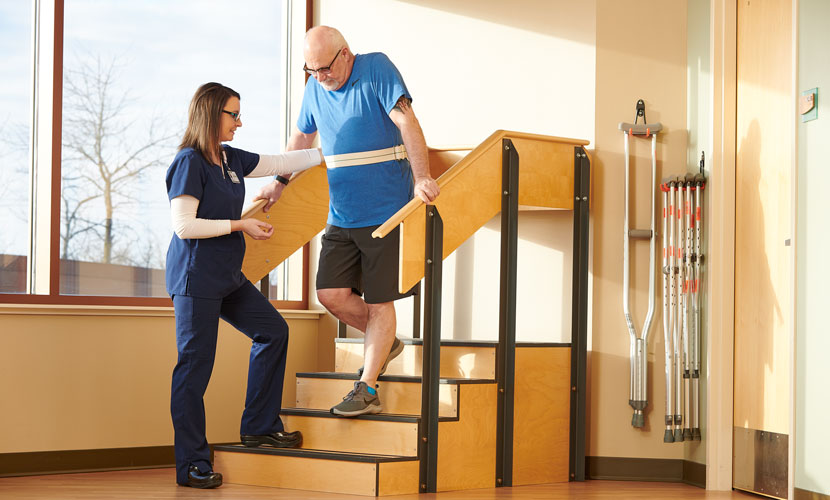Total Joint Replacement Program
If your hips or knees aren’t functioning properly, it’s not just bothersome, it’s an impact on your daily life — which is likely why hip and knee replacements are two of the most common orthopedic procedures done in the United States. In 2018, Maple Grove Hospital completed 901 operations, including 488 knee replacements and 259 anterior minimally invasive hip replacements, which lately is one of the most sought-after procedures.
John Cook was one of the patients who had his hip replaced at Maple Grove Hospital last June. “Over the years I’ve had numerous operations at other hospitals, so I was expecting the worst,” says Cook. “Maple Grove Hospital is different. The experience I had this time was unbelievable. Everyone was extremely friendly, helpful and there to make it a success.”
The Total Joint Replacement Program at Maple Grove Hospital is designed to give patients a roadmap to their surgery and recovery, helping them set expectations, prepare properly and feel educated and empowered. Prior to surgery, patients have the option to attend a preoperative class, at which the staff walks you step-by-step through surgery and recovery. You’ll have a chance to tour the Joint Center and learn what to expect during your stay, how to prevent postoperative complications and which assistive devices are available.

Patients also have the option to attend a mindfulness class, which teaches breathing and other techniques to help reduce pain, anxiety, stress, nausea or other discomfort. These classes focus on supporting your overall well-being. “Comfort is our top priority,” says Jen Hagen, nurse clinician and educator. “That’s why we offer integrative techniques to support current medical treatment, relieve discomfort and promote wellness.”
In addition to the mindfulness class, patients have access to other holistic offerings, including aromatherapy, healing touch massage and guided imagery. “I recently went into the room of a patient who was having some pain,” recalls Hagen. “She started practicing the breathing and guided imagery techniques she’d learned and was able to quickly decrease her pain level.” Every patient is also provided with a guidebook, which Cook, in particular, found to be very helpful. It’s an education tool, detailing what to expect before, during and after surgery, as well as how to care for your new joint postoperatively.
“I think the more you can educate and empower the patient, the better off they’re going to be,” says Hagen. “And our patients appreciate it. They feel informed and well prepared, as well as supported and cared for.”
Aside from the preparatory classes and tools, patients can feel confident knowing that the Total Joint Replacement Program surgeons stay on the cutting edge of techniques and procedures, including being a leader in the anterior surgical approach, which enables faster recovery and lowers the risk of complications.
“I try to make the surgery as reliable, consistent and comfortable as possible,” says Dr. Brian O’Neill, a Twin Cities Orthopedics surgeon who performed Cook’s hip replacement. “I focus on the longevity of the replacement and ensuring that the patient has good function following the surgery so that they have an improved and pain-free daily life.”
Along with the surgeon, the patient will interact with a multidisciplinary team, including hospitalists, nurses, physical therapists, dietitians and other specialists. “Our team is specifically trained to meet the patient’s needs,” says Hagen. “We take their preferences into account when managing their hospital stay, letting their goals lead the way.”
The rooms are just one example of an element created with the patient in mind. They are all private and designed specifically for joint replacement patients, equipped with an orthopedic recliner and an attached bathroom with a zero-entry shower and raised toilet seat. Cook recalled that because the rooms were so nice, he almost wished he could’ve stayed longer. However, his surgery was so successful that he only needed to be at Maple Grove Hospital for one night.
“When I came to, I didn’t have pain anymore,” says Cook. “I couldn’t feel much, but still, there was a difference. By the time I got out of my grogginess that night I was on my feet, walking without a cane or walker. I shocked a lot of people, but I was like, ‘Hey, I feel good.’” Cook’s case was exceptional, but Dr. O’Neill says there’s a misconception that these are terribly painful surgeries. In fact, most patients no longer need medication after four or five days and are fairly mobile following the surgery.
Cook credits part of his success to being in shape prior to surgery as this played a big role in his recovery. It has been shown that exercising and strengthening your body prior to surgery can be helpful in aiding in recovery. However, Dr. O’Neill says sometimes doing exercises prior to surgery can cause more pain than good, so he recommends consulting your doctor first.
Other things you can do to prepare, include eating a healthy diet comprised of enough protein, fiber and calcium-rich foods, getting your home ready and lining up any necessary help for the time you’re recovering.
Now, close to one year after Cook’s surgery, he’s doing great and staying active in whatever way he can. “It was just a fantastic experience. It’s almost like I want to do it again,” laughs Cook. “Hopefully I won’t need anything else replaced, but if I do, I’ll go to Maple Grove Hospital, that’s for sure.”
Maple Grove Hospital is one of two sites within the North Memorial Health system that offers total joint surgeries. Robbinsdale Hospital is the other.


